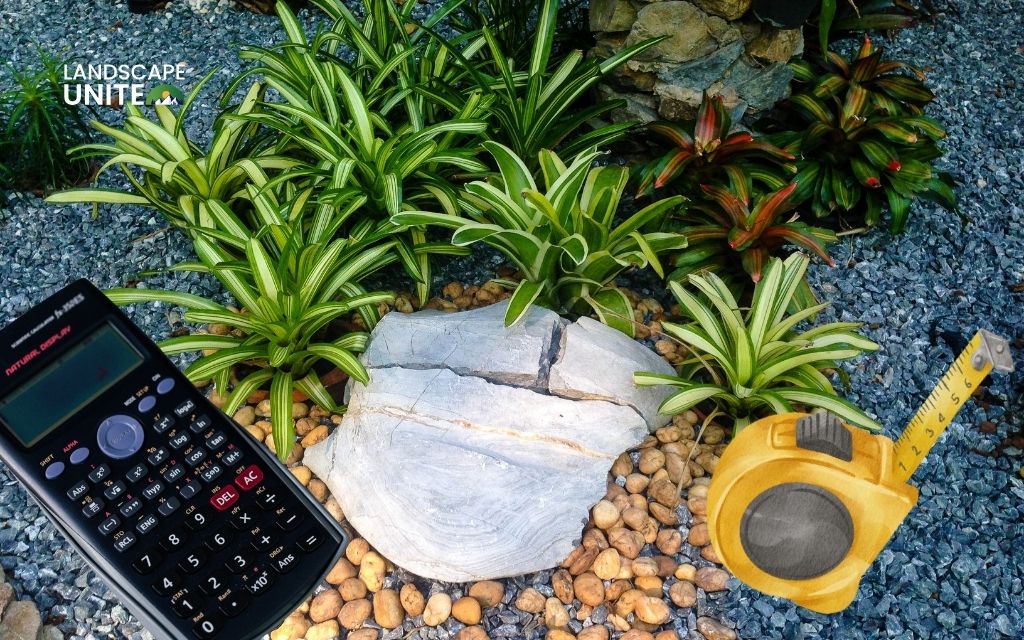As autumn arrives and temperatures begin to drop, many homeowners wonder whether their lawn care responsibilities are winding down.
The truth is, fall presents one of the most critical windows for lawn maintenance and selecting the right fertilizer during this season can make the difference between a struggling lawn and one that emerges vibrant and healthy come spring.
Understanding what fertilizer to use in fall, along with proper timing and application techniques, sets your lawn up for success through winter’s challenges and into the growing season ahead.
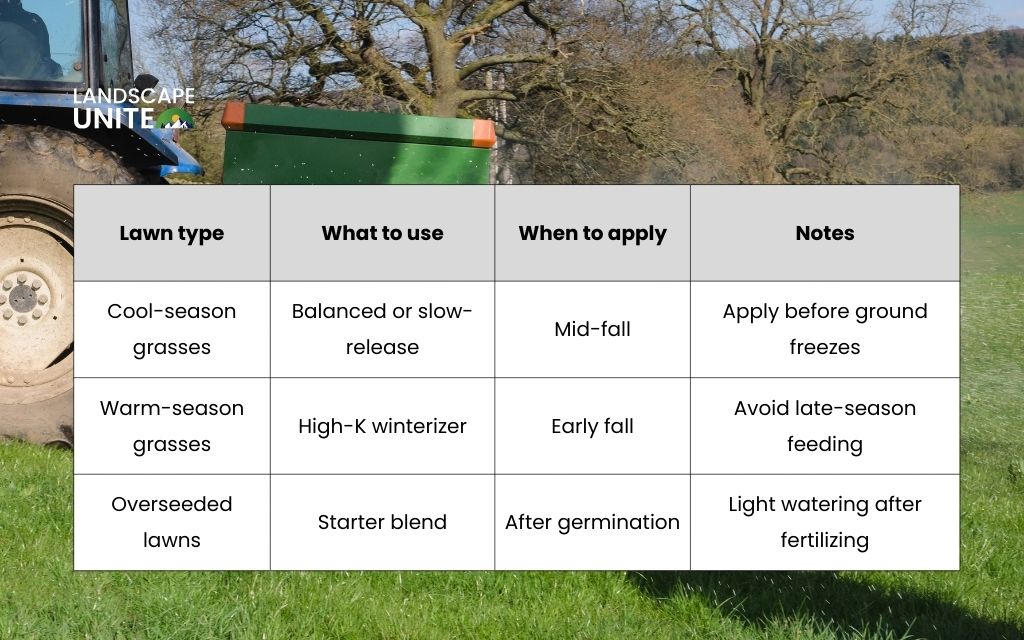
What fertilizer to use in fall?
Fall fertilizers differ from spring ones in a crucial way: they focus on root strength and winter preparation rather than leaf growth. Here are the main types you’ll encounter:
Slow-release nitrogen fertilizers
This is your best choice for steady, long-term feeding. These fertilizers release nutrients gradually over weeks or months, preventing waste and giving your lawn consistent nourishment as temperatures drop. They won’t cause excessive leaf growth that could be damaged by frost.
High-potassium (k) or winterizer formulas
These “winterizer” fertilizers contain extra potassium to help your grass survive winter stress. Potassium strengthens grass roots and improves resistance to cold, drought, and disease. Look for fertilizers with higher K numbers on the package.
Balanced blends
If you’re planting new grass seed in fall, choose a balanced fertilizer that feeds both your existing lawn and new seedlings. These provide gentle, even nutrition without overwhelming delicate new roots.
Organic vs synthetic options
- Organic fertilizers work slowly and improve soil health over time, but may need earlier application since they release nutrients gradually.
- Synthetic fertilizers work quickly with precise nutrient ratios, but require careful timing to avoid runoff during heavy rains.
When to apply fall fertilizer
The simple answer: Apply 4 – 6 weeks before your first expected frost.
Timing by region
- Northern states: Late September to early October
- Southern states: October to November
- Check your local frost dates and count back 4-6 weeks for your exact timing
Why this timing matters
Your grass needs time to absorb nutrients while it’s still actively growing. Too early, and you’ll encourage summer growth that wastes energy. Too late, and your grass can’t use the nutrients before going dormant.
Special case: overseeding
If you’re planting new grass seed:
- Seed first, then wait
- Apply fertilizer 2-3 weeks after seeding
- Wait until new grass is about 1 inch tall
This ensures new seedlings are strong enough to handle fertilizer without being burned.
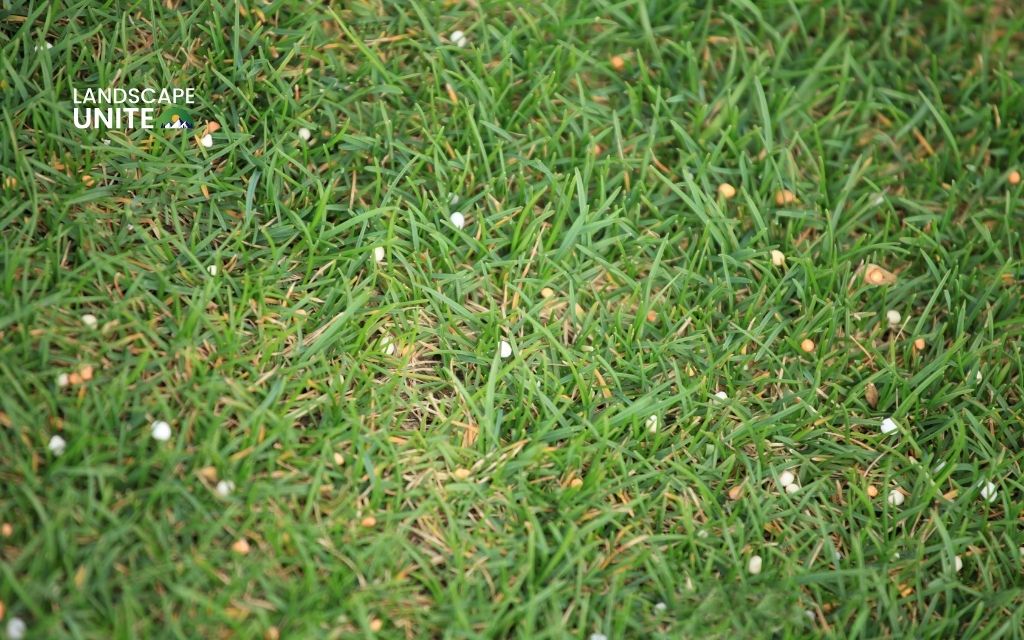
How to choose the right fertilizer for your lawn
Selecting the most appropriate fall fertilizer depends primarily on your grass type, with warm-season and cool-season grasses having distinctly different nutritional needs and timing requirements.
Warm-season grasses
Warm-season grasses including Bermudagrass, Zoysia, St. Augustine, and Centipede require high-potassium winterizer formulations applied in early fall.
These grasses begin their dormancy preparation earlier than cool-season varieties, making early September the ideal application window in most regions.
The high potassium content helps these grasses develop cold tolerance and survive temperature fluctuations while maintaining root health during dormancy.
Avoid late-season nitrogen applications that could stimulate growth when these grasses should be hardening off for winter.
Cool-season grasses
Cool-season grasses such as Fescue, Kentucky Bluegrass, Ryegrass, and Bentgrass benefit from balanced fertilizers or slow-release nitrogen formulations with potassium enhancement.
These grasses continue active growth longer into fall, making mid-fall applications (October in most regions) ideal for supporting continued root development and winter preparation.
Why fall fertilizing is essential
Fall feeding serves multiple critical functions that directly impact your lawn’s long-term health and appearance.
Root system development
During fall’s moderate temperatures and increased moisture, grass plants shift energy from leaf production to root development.
Proper fertilization during this period supports extensive root growth, creating a more robust foundation that improves nutrient and water uptake capacity.
This enhanced root system provides better drought tolerance and overall plant health.
Recovery from summer stress
Summer’s heat, drought, and traffic stress leave lawns depleted and weakened. Fall fertilization provides the nutritional support needed for recovery, helping grass rebuild energy reserves and repair damage accumulated during the challenging summer months.
Winter hardening process
Proper fall nutrition supports the natural winter hardening process, helping grass develop the physiological changes needed to survive freezing temperatures.
Enhanced carbohydrate storage, improved cell wall strength, and increased cold tolerance all result from appropriate fall feeding.
Spring color and vigor
Lawns that receive proper fall nutrition consistently demonstrate superior spring green-up, earlier growth resumption, and better overall vigor. The nutrients stored during fall feeding provide the energy needed for rapid spring growth and vibrant color development.
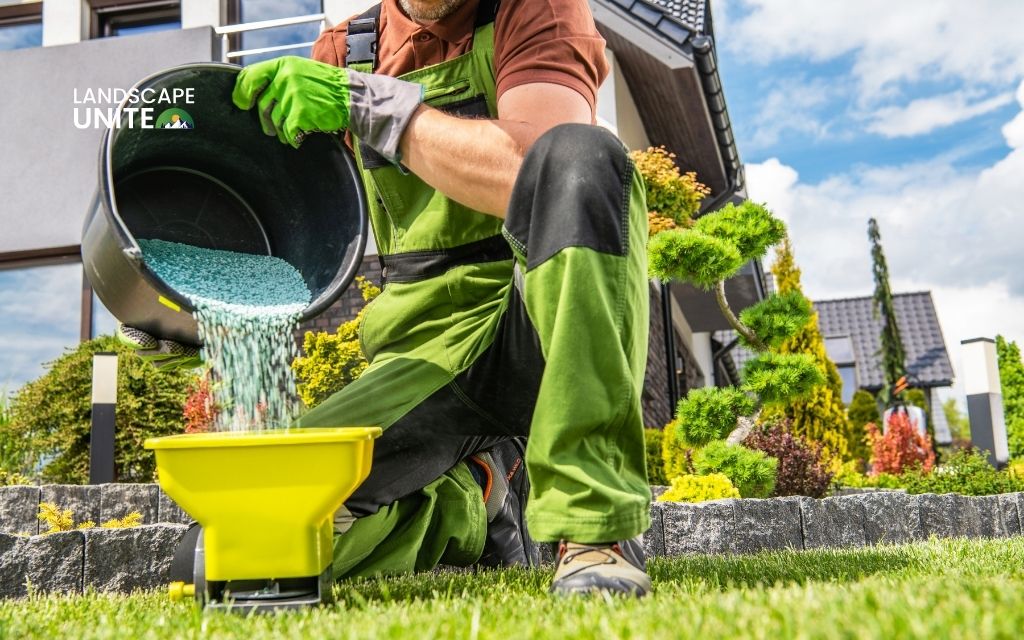
How to apply fertilizer in fall
Proper application technique is just as important as selecting the right fertilizer, ensuring even distribution and optimal nutrient uptake while preventing waste and environmental impact.
Step 1: Prepare your lawn first
Begin with proper lawn preparation to maximize fertilizer effectiveness. Mow your grass slightly shorter than usual – about one-quarter to one-third shorter – to improve soil contact and reduce interference with granule distribution. Remove debris including fallen leaves, thatch buildup, and any other materials that could prevent even application.
Water your lawn lightly 24 hours before application to ensure adequate soil moisture without creating overly wet conditions that could interfere with spreader operation or cause uneven distribution.
Step 2: Use the right spreader
Select the appropriate spreader type based on your lawn size and configuration. Broadcast spreaders work effectively for large, open lawn areas, providing wide coverage patterns and efficient application.
Drop spreaders offer more precise control for smaller areas, tight spaces, or situations requiring exact placement control.
Always consult the fertilizer package for recommended spreader settings, as different products require different application rates. Calibrate your spreader according to manufacturer instructions to ensure accurate application rates.
Step 3: Apply evenly in two directions
Employ the crisscross application method for optimal coverage uniformity. Make your first pass in one direction (north-south), then make a second pass perpendicular to the first (east-west). This technique ensures even distribution and prevents the striping or burn patches that can result from uneven application.
Overlap slightly between passes to eliminate gaps, but avoid excessive overlap that could result in over-application and potential burning.
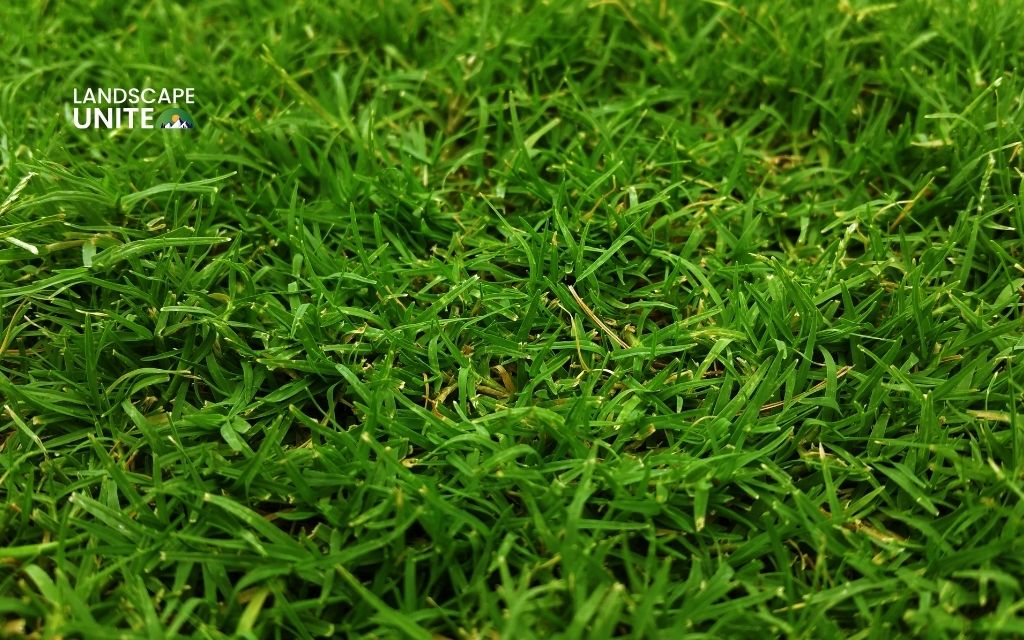
Step 4: Water after application
Light watering following application helps activate granular fertilizers and begins the nutrient release process. Apply approximately one-quarter inch of water – enough to dissolve granules and move nutrients toward root zones without causing runoff or leaching.
Step 5: Safety & cleanup tips
Sweep any fertilizer granules from hard surfaces including driveways, sidewalks, and patios back onto the lawn or collect for proper disposal. These areas can become sources of nutrient runoff during rain events.
Wash hands thoroughly after handling fertilizer products and clean application equipment to prevent corrosion and ensure accurate future applications. Store unused fertilizer in a cool, dry location away from children and pets.
Conclusion
Selecting the right fall fertilizer and applying it with proper timing and technique creates the foundation for outstanding lawn health through winter and into the following growing season.
The investment in appropriate fall fertilization pays dividends through improved winter survival, enhanced spring green-up, and overall lawn resilience against seasonal stresses.
Take action this fall to give your lawn the nutrition it deserves. Your spring lawn will reflect the care and attention you provide during these crucial autumn months.
Find further proven lawn care methods and maintenance schedules in our comprehensive garden guide, where expert recommendations assist you in developing the healthy, stunning lawn of your dreams.
Frequently asked questions (FAQs)
Should I fertilize after overseeding in the fall?
Yes, fertilizing after overseeding supports both established turf and new seedlings. Use a gentle starter fertilizer or balanced formulation once new grass begins growing, typically when seedlings reach about one inch in height. This ensures adequate nutrition without overwhelming delicate new roots.
When exactly should I apply fall fertilizer?
Apply fall fertilizer 4-6 weeks before your region’s first expected frost date. This typically means late September to early October in northern climates and October to November in southern regions. Check local weather forecasts and historical frost dates for precise timing in your area.
How do I avoid over-fertilizing my lawn?
Prevent over-fertilization by using the correct spreader settings according to package directions, applying fertilizer in two perpendicular directions for even coverage, and strictly following recommended application rates. Never exceed package-recommended rates.
Can I use spring fertilizer in fall?
No, spring fertilizers are formulated with high nitrogen content designed to promote rapid leaf growth, which is counterproductive in fall. Fall fertilizers emphasize potassium and controlled-release nitrogen for optimal seasonal benefits.
